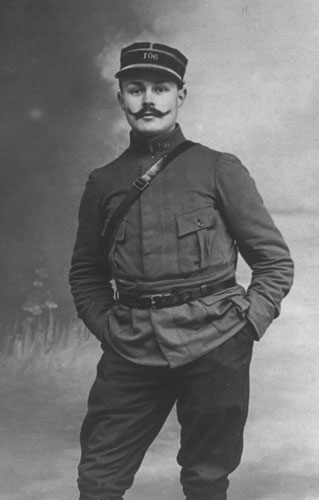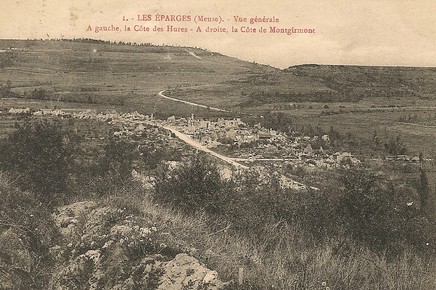Etape 18 : Les Eparges
Les combats des Hauts de Meuse
 |
Etape 18 : le régiment atteint le village des Eparges pour la première fois le durant la première vingtaine d'octobre 1914. Ce village est au cœur de l'œuvre de Maurice Genevoix. |
Le village sera à maintes reprises visité par le 106ème RI qui y prend position avant de monter à la crête pour tenter d'arracher son sommet aux allemands. Les allemands qui tiennent les hauteurs le bombardent régulièrement et les tireurs d'élites allemands obligent les soldats à rester à couvert. Ils tuent aussi les animaux dans les prés. Le village déjà durement éprouvé à leur arrivée ne cessera de subir de lourds dégâts. C'est sur ces hauteurs que Maurice Genevoix perdra son ami le lieutenant Porchon en Février 1915 lors de très violents combats.

 Herbst 1914 und April 1915: Maurice Genevoix und Ceux de 14 sind sehr regelmäßig im Dorf und am Hügel, der es beherrscht. Der französische Generalstab interessiert sich für diese strategische Position, die einen ausgezeichneten Beobachtungspunkt über das Woëvre-Tal darstellt, und will sie den Deutschen entreißen. Diesem Sektor fällt bei der Kontrolle der Hauts de Meuse eine Schlüsselrolle zu. Die Männer machen immer Halt im Dorf, bevor sie an die Frontlinie, in die Schützengräben, auf den Hügel vorrücken. Im Dorf verstecken sich die Soldaten tagsüber in den Häusern vor den Deutschen Scharfschützen. Maurice Genevoix findet Zuflucht im Rathaus oder Pfarramt, das er mit seinem Freund Porchon teilt. Von dort aus sehen sie bei jedem Aufenthalt das Dorf in Trümmer fallen und das erschossene Vieh auf den Weiden der Umgebung. Die heftigsten Kämpfe finden auf dem Hügel am 17. Februar 1915 statt. Maurice Genevoix führt 120 Mann hinauf und kommt mit 17 Unversehrten wieder hinunter. Porchon wird getötet, sein Grab befindet sich auf dem nationalen Friedhof Trottoir am Fuße des Hügelkamms von Les Eparges.
Herbst 1914 und April 1915: Maurice Genevoix und Ceux de 14 sind sehr regelmäßig im Dorf und am Hügel, der es beherrscht. Der französische Generalstab interessiert sich für diese strategische Position, die einen ausgezeichneten Beobachtungspunkt über das Woëvre-Tal darstellt, und will sie den Deutschen entreißen. Diesem Sektor fällt bei der Kontrolle der Hauts de Meuse eine Schlüsselrolle zu. Die Männer machen immer Halt im Dorf, bevor sie an die Frontlinie, in die Schützengräben, auf den Hügel vorrücken. Im Dorf verstecken sich die Soldaten tagsüber in den Häusern vor den Deutschen Scharfschützen. Maurice Genevoix findet Zuflucht im Rathaus oder Pfarramt, das er mit seinem Freund Porchon teilt. Von dort aus sehen sie bei jedem Aufenthalt das Dorf in Trümmer fallen und das erschossene Vieh auf den Weiden der Umgebung. Die heftigsten Kämpfe finden auf dem Hügel am 17. Februar 1915 statt. Maurice Genevoix führt 120 Mann hinauf und kommt mit 17 Unversehrten wieder hinunter. Porchon wird getötet, sein Grab befindet sich auf dem nationalen Friedhof Trottoir am Fuße des Hügelkamms von Les Eparges.
|
"Das letzte Geschoss, das in den Trichter 7 eingeschlagen hat, hat Porchon am Kopf verletzt (…) Es ist Rolland, der das alles erzählt (…): Geh runter, mein Alter. Sei kein Idiot … und er geht hinunter. Er kommt am Ende des Laufgrabens an, genau auf Höhe des Sanitätspostens … Und dort hat ihn eine 77er getötet. Maurice Genevoix - Ceux de 14 - Editions Flammarion |
 Autumn 1914 and April 1915 : Maurice Genevoix and Those of 14 pay frequent visits to the village and the hill that overlooks it. The French general staff is interested in this strategic position, a very good lookout point over the Woëvre plain, over which they are fighting with the Germans. This sector is essential for control of Les Hauts de Meuse. The men always stop by the village before going to the front, in the trenches, on the hill. In the village, the soldiers hide in the houses during the day, to escape the German marksmen. Maurice Genevoix takes refuge in the town hall or the presbytery, which he shares with his friend Porchon. Each time they stay there, they see the village fall further into disrepair and the livestock being slaughtered in the surrounding fields. The most violent fighting takes place on the hill on 17 February 1915. Maurice Genevoix leads 120 men and comes back with 17 unscathed. Porchon meets with death there; his grave is at the Trottoir national necropolis at the foot of the Eparges ridge.
Autumn 1914 and April 1915 : Maurice Genevoix and Those of 14 pay frequent visits to the village and the hill that overlooks it. The French general staff is interested in this strategic position, a very good lookout point over the Woëvre plain, over which they are fighting with the Germans. This sector is essential for control of Les Hauts de Meuse. The men always stop by the village before going to the front, in the trenches, on the hill. In the village, the soldiers hide in the houses during the day, to escape the German marksmen. Maurice Genevoix takes refuge in the town hall or the presbytery, which he shares with his friend Porchon. Each time they stay there, they see the village fall further into disrepair and the livestock being slaughtered in the surrounding fields. The most violent fighting takes place on the hill on 17 February 1915. Maurice Genevoix leads 120 men and comes back with 17 unscathed. Porchon meets with death there; his grave is at the Trottoir national necropolis at the foot of the Eparges ridge.
|
"The last shell that fell on shell-hole 7 hit Porchon in the head (…) Rolland tells me all about it (…): come down, mate. You’re being a fool… and he comes down. And he gets to the bottom of the tunnel, just level with the first aid post... And that’s where a 77 killed him Maurice Genevoix - Ceux de 14 - Editions Flammarion |
